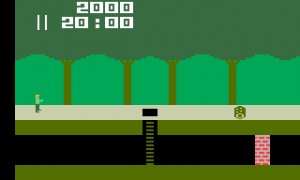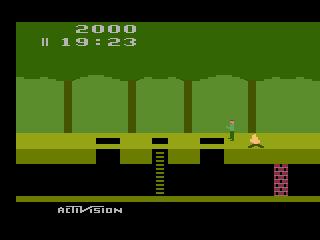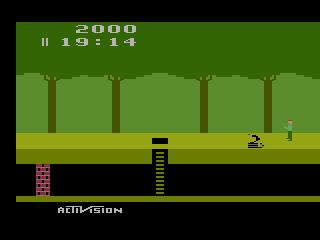Another game that my brother and I had while growing up. I think we got it just because we had enjoyed it so much on our friends’ Atari systems. I remember getting it, and thinking “Yep, that’s Pitfall.” We all thought Pitfall was a great game. And I guess it’s decent as far as it goes. The gameplay gets pretty repetitive.
If you’ve never played Pitfall, you really need to. It’s one of those classic games that has developed legendary status. It was one of the first cartridges to come out of Activision (am I remembering that right?) and the graphics were just so much better than most of what was out for the Atari 2600 at the time. The game was just seen as “cool!” by me and every gamer I knew at the time.
You quickly learn that it is much easier to play the game running to the left. All the logs roll right to left and when you die your new man shows up on the left. I remember playing the game for a while just enjoying the movement of the man and the action of swinging on vines, jumping snakes, etc. And then there were treasures to grab as well!
A “secret” of the game that isn’t obvious when you first play (but is probably mentioned in the game documentation — but who reads that??!!) is that the underground passages skip three screens for every screen you cover above ground. So the secret to moving through the game is to use the underground passages.
It is possible to get a perfect score of 114,000 points. This requires that you get all 32 treasures in under 20 minutes. Since you lose points for any fall or touching of a log, it requires pretty skillful play. And no, I’ve never achieved it myself. If you’re interested in a bit more info on playing a perfect game of Pitfall, you can read this article from issue 40 of the Retrogaming Times.
But playing Pitfall again for a bit for this review makes me want to play it more. I’d like to play it far enough to at least collect all the treasures. I doubt I’ll put enough effort into the game to get that perfect score, though.
Get a map
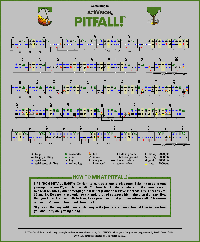 The only way to beat this game is to follow a map. You’re never going to get through all 255 screens just running. 20 minutes just isn’t enough time. You’ll need to take advantage of the underground passages.
The only way to beat this game is to follow a map. You’re never going to get through all 255 screens just running. 20 minutes just isn’t enough time. You’ll need to take advantage of the underground passages.
I started what I hoped would eventually be a comprehensive map of Pitfall. But I only mapped 30 or 40 of the screens before I decided to move on to other projects. With the advent of the internet, you can find several Pitfall maps around. One of the better ones I’ve seen was at “Pitfall Harry’s Lost Video Game Cavern” which was one of those transient tripod hosted sites. Fortunately, I was able to make that map available here as that site has disappeared.
I’m giving INTV Pitfall an arcadeability rating of 5. I find nothing sluggish in the control of Pitfall Harry on my cab. I’m using a 4-way joystick, so that keeps things decently crisp.
Controls mapping
The controls mapping for this game is very simple. Just the normal 4-way cursor mapping to N, S, E, and W on the INTV controller and two arcade buttons mapped to the top and bottom side action buttons. The arcade.kbd configuration is fine for this game.
How does it compare to the original arcade game?
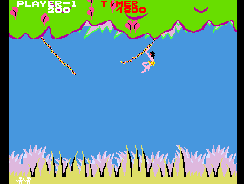
I guess the arcade game that Pitfall comes closest to would be Jungle King (or Jungle Hunt).
But Pitfall isn’t meant to be a Jungle King port. There is no “rescue the girl” quest kind of back-story. You’re just a guy running through a jungle getting treasures. Actually, Activision kind of made their reputation on original games. They didn’t bother attempting to get the expensive arcade licenses to do ports, rather they just attempted to create good original games. There is no denying that some of their games played decently like a particular arcade game, but it really isn’t fair to judge an Activision game against an arcade game.
It does make sense to compare Activision INTV titles against their Atari counterparts, however. And in that comparison, INTV Pitfall falls short. But only because we’ve come to expect more. It seems that Activision didn’t do much to spice up this game and take advantage of the better processing power that the INTV has at its disposal. Pitfall pretty much looks like a direct port of the Atari 2600 version. There’s a little more detail in the money bag and the bricks in the walls, but the fire and the snake look better on the Atari 2600.

